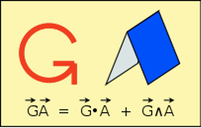Previous section: Velocity Composition.
Next section: Energy and Momentum.
Active Lorentz transformations.
The Lorentz transformation X = V X′ (or X' = Ṽ X) is interpreted passively as a change of labels for a single event. This is analogous to a 2D spatial rotation of unprimed axes CCW into primed axes and reading the new coordinates of a fixed vector, making it seem that the fixed vector had rotated CW.
Alternatively, it can be interpreted actively as a relation between two different events that are the same proper distance |X′| = |X| = cτ from the origin. This is analogous to the 2D spatial rotation in the previous paragraph, where we now have only one coordinate system but are actively rotating the vector CW. Instead of rotating the axes one way, we are rotating the vector the other way. Therefore, using an active interpretation, the Lorentz transformation becomes X' = V X (or X = Ṽ X'), where, in either case, V = γ(1 + v/c) represents
(for the passive interpretation) the relative spacetime velocity of the primed frame
with respect to the unprimed frame
or
(for the active interpretation) the relative spacetime velocity of event vector X' with respect to X.
Saying this another way,
in the passive interpretation, applying V to the unprimed frame to get the primed frame is equivalent to
applying Ṽ to the unprimed coordinates to get the primed coordinates,
and in the active interpretation, applying V to event vector X boosts it into another event vector X'.
As in the 2D spatial rotation case, an active transformation of an event vector by Ṽ is equivalent to a passive transformation of its frame by V. In either case, we write X' = Ṽ X. In the active interpretation, X and X' refer to different event vectors. In the passive interpretation, they refer to coordinates in different frames for the same event.
Advanced Exercise: Interpret the active Lorentz transformation in the figure as a hyperbolic rotation of proper velocity.
The rotation angle a = |a| is the arc length (spacetime, not Euclidean) on a unit hyperbola
(see the solution link below for proof of this), as expressed by
Construct a diagram to express velocity composition as a product of hyperbolic rotations:
and compare with the product of Euclidean rotations:
(Click here for a solution to this exercise.)
Previous section: Velocity Composition.
Next section: Energy and Momentum.
